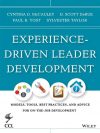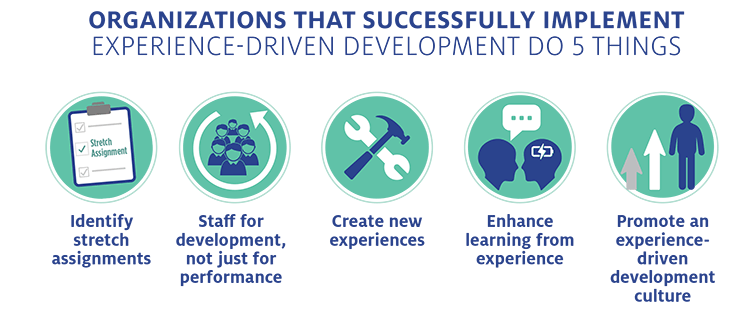Put Experience at the Center of Talent Development
As business landscapes continue to change and shift, HR leaders face recurring questions:
Can leaders be developed quickly enough to meet demand? Could leaders better take advantage of current talent management processes and efforts? How can we help line managers develop and manage their talent more effectively?
Learning from experience is the best way to develop talent. Yet most organizations aren’t maximizing on-the-job opportunities that prepare leaders, develop employees, and advance business goals.
The key is to make experience-driven leadership development intentional.
HR leaders understand this and often follow the 70-20-10 framework, based on a CCL study, which reflects the relative impact of 3 types of experiences on executive development:
- 70% of learning comes from on-the-job experiences and challenges.
- 20% of learning comes from other people.
- 10% of learning comes from courses and formal training.
The “70%” reflects the primary way development happens: through on-the-job experiences and challenges. But most organizations aren’t maximizing on-the-job opportunities that prepare leaders, develop employees, and advance business goals.
Many HR and business leaders think they could do more but lack a cohesive plan.
Our researchers combined their talent management work with experience-driven development research to map out recommendations for HR leaders looking to be more strategic about the 70%.
Make Experience-Driven Development Part of Your Culture
As noted in our white paper, experience-driven talent development is when experience — carefully designed and executed — becomes the core driver of learning in the organization. Working and learning are bound together, aligned with the business strategy and shaped by a talent strategy.
When this kind of development is part of the organizational culture and embedded in all of talent management, you’ll see things such as:
- Senior leaders who support stretch assignments as a key strategy for developing employees;
- Highly-valued employees being routinely shared with other parts of the organization; and
- Development opportunities considered when making decisions about how to staff key projects.
Millennials, in particular, desire the opportunity to learn from on-the-job experiences.
Challenging assignments — also called stretch assignments — are at the heart of experience-driven development, and help to attract and retain talent. Such assignments put individuals in new or uncertain situations where they have to take action, see direct outcomes, and refine their approach to be more successful.
Over time, these cycles of action and adjustment build new skill sets and deeper expertise.
Challenging assignments typically have one or more of these elements: facing unfamiliar or broader responsibilities, creating change, influencing across organizational boundaries, and working with diverse sets of people. At CCL, sometimes we refer to these as “heat experiences,” and they can be major drivers of on-the-job learning.

Learn how your organization can use on-the-job experiences to enhance their leadership talent with this collection of best practices, tools, techniques, processes, and strategies.
Embed Experience-Driven Development Into Your Talent Management Efforts
Learning and development are often walled off from, or only loosely tied to, the larger talent management system. But experience should be at the center of it all. Experience-driven talent management involves 3 components:
- Talent strategy;
- Talent processes; and
- Talent roles.
Talent Strategy
A talent strategy articulates decisions guiding how the organization will attract, develop, and retain the talent needed to achieve its business strategy. The talent strategy begins with a clear understanding of the business strategy and provides guidance for the critical investments an organization will or will not make in people. At a high level, it identifies the critical positions or key players that are essential for the business strategy to be successful and important capabilities to be developed.
A talent strategy may set the direction for a high-priority need alone, or it may include the direction for the development of employees overall. For example, a professional services firm with an ambitious growth plan may have a talent strategy based on recruiting seasoned experts: “Seek out the most knowledgeable individuals in our field with a strong track record of success in our industry or a related one, and provide them with the opportunity to innovate, learn, and grow.”
Talent Processes
Talent processes are the formal programs and structures organizations use to be intentional and systematic about attracting, developing, and retaining talent. They’re the essential activities talent management carries out in service of the larger talent strategy: setting success profiles; recruiting, hiring, and onboarding; learning and development; performance management; rewards and recognition; staffing and succession management; employee engagement; and so on.
These are things you’re probably already doing in some fashion, but they look different through an experience-driven development lens. For example, you may add learning agility as a core competency when selecting and evaluating employees. In hiring, you may put more weight on certain experiences (global travel or start-up, for instance), especially those that are needed but not strongly reflected in the current talent pool.
Talent Roles
Talent roles address the people throughout the organization who impact talent attraction, development, and retention in very different ways. While this has historically been an HR role, talent management is quickly becoming a priority among senior leaders and managers who know they need the right pool of people involved — in the present and the future.
Everyone has a part to play in leveraging on-the-job learning, including the board of directors and individual employees, but Human Resources, Training & Development, and Organizational Development leaders are the catalysts. You design and facilitate experience-driven talent management processes that support business strategy and engage employees. You educate others about their role in talent management and help them take on these roles. You monitor the effectiveness of the talent management system overall.
How to Increase On-the-Job Learning at Your Organization: Evolve Your Mindset
Putting experience-driven development and on-the-job learning at the center of talent management takes a shift in mindset and culture, along with changes in strategy, process, and roles.
If all elements of the talent system are going to enable and support learning from experience, people need to see learning everywhere.
When learning from experience is embedded in the culture, the gap between doing the work and developing the people shrinks. Learning isn’t added on. Coaching, mentoring, and aligning talent aren’t initiatives — they’re the way people work. Learning agility is a valued competency, and it’s a normal part of the conversation.
The work of talent management, then, is to help individuals notice what should and could be learned from experience, and to find ways to help the organization capitalize on that learning potential.
Putting experience-driven development at the center of talent management will boost an organization’s efforts to attract and retain talent and accelerate the development of leaders at every level.

Organizations that successfully implement experience-driven development and leverage on-the-job learning do these 5 things:
1. Identify stretch assignments.
Some experiences are more developmental than others; consider the different experiences that help people learn to lead. Identifying stretch assignments includes:
- Developing a shared language for talking about stretch assignments.
- Mapping competencies to stretch assignments.
- Creating experience paths for targeted positions or roles — such as a general manager role or those on a high-potential track.
- Reserving specific key jobs to use for development only.
2. Staff for development, not just for performance.
Matching specific individuals with the right experience requires rigor. The key with experience-driven development is to consider the need to hone new skills and perspectives, not simply make assignments based on past success or current role. Staffing for development includes:
- Putting processes in place to identify the next assignment needed for each high-potential to continue broadening their portfolio of experience and increasing their engagement and retention.
- Making sure that everyone has a “development-in-place” assignment — something in their current job that challenges and supports targeted development.
- Staffing key projects with development in mind, asking, “Who could benefit from this experience?”
- Developing managers’ skills at assignment-based development to be sure they’re able to identify, implement, and support stretch assignments.
3. Create new experiences.
This requires that enough of the right experiences exist to develop people in the needed ways. Expanding the array of developmental assignments involves:
- Creating new types of experiences to meet the strategic needs of the organization — more cross-functional, cross-country, new market, and new client opportunities, for example.
- Including developmental assignments in formal development programs — this might be in the form of action-learning projects, special assignments, or job-rotation experiences.
- Supporting the pursuit of leadership experiences beyond the workplace, such as volunteer work, board membership, or roles with professional organizations that address development needed in the workplace.
4. Enhance learning from experience.
Going through an experience doesn’t guarantee a person will learn from it. Support is essential. Organizations need to surround work development experiences with effective learning practices and help individuals understand how to use their experiences to fuel leadership development. This might include:
- Tools for reflecting on experience and feedback.
- Access to relationships for learning, such as mentors, peer networks, and communities of practice.
- Coaches who challenge and support explicit learning goals and experience-driven development.
- Formal coursework and online resources that provide just-in-time learning tailored to the challenges of the specific stretch experience.
5. Promote an experience-driven development culture.
When learning from experience is embedded in the culture, the gap between doing the work and developing the people shrinks. Learning isn’t added on — nor is coaching and aligning talent. An experience-driven development culture includes:
- Hiring, developing, recognizing, and rewarding senior leaders who visibly support experience-driven development.
- Communicating and tracking on-the-job development.
- Rewarding employees for their own development and for developing others.
- Valuing learning agility as a core competency — recruiting for it, selecting for it, and developing it.
Learning opportunities are everywhere and everyone knows it. The purpose of talent management, then, is to help individuals notice what should and could be learned from experience and to find ways to help the organization capitalize on that learning potential.
By facilitating a shift in mindset and culture, along with changes in strategy, process, and roles, HR can improve the process of attracting and retaining talent and developing leaders.
Ready to Take the Next Step?
We’re ready to partner with you to craft experience-driven talent development that builds critical leadership skills and competencies that are right for your organization’s unique context and culture. Learn more about our Talent Development solutions.









